Honda Insight Relies on Copper
Copper Applications in Automotive Area
The Honda Insight, the first mass-produced hybrid offered for sale in this country should be in dealer showrooms now. According to Honda, it will have a Manufacturer's Suggested Retail Price (MSRP) of $18,880 ($20,080 with factory installed automatic climate control). Since, by definition, the hybrid is based at least partly on propulsion by an electric motor, it is not surprising that the vehicle relies extensively on the high electrical conductivity—and therefore high electrical efficiency—provided by copper.
General Description
The Insight is a two-seater, somewhat similar in size and appearance to the old Honda CRX. With an EPA-rated 61 mpg city and 70+ mpg highway, and a special NOx absorbing catalyst, the Insight easily qualifies as an Ultra-Low Emissions Vehicle (ULEV) by California emission standards. It will have a range of 600 to 700 miles with only a 10.6 gallon gas tank and Honda is confident the insight will overcome consumer concerns about the limited range and recharging times of pure electric vehicles. The approach that Honda is taking is often referred to as a mild hybrid. The vehicle has a small supplemental electrical system that gets its charge by absorbing energy from the gasoline engine when the car is not accelerating, or by converting mechanical energy when the brakes are applied and the driver slows down.
A new high-tech powertrain makes this all possible. The Insight features the Honda Integrated Motor Assist System (IMA), combining a 1.0 liter, 3-cylinder gasoline engine with electric motor assist for improved efficiency. Power for the electric motor is supplied by a nickel metal hydride (NiMH) battery pack that is recharged when the motor acts as a generator during deceleration and braking. As a result, the insight does not require an outside source of electric power and never needs to be "plugged-in" for recharging.
The Insight has a wealth of new technologies that could show up on other hybrids or even on new conventional vehicles. One of these is what Honda calls idle-stop. This means that when the speed slows to less than 5 miles per hour, the engine shuts off. Pushing in the clutch and putting the shift lever into first gear starts the engine again. This transition is so fast that the engine will be running smoothly before the driver can let the clutch out.
Features and Accessories
The Insight has an impressive list of comfort and convenience features for a vehicle that was designed primarily for good fuel economy and low emissions. These features include anti-lock brakes, dual airbags, power windows, power mirrors and door locks, optional air conditioning, AM/FM stereo cassette player and map lights. Security features include a Theft-Deterrent System and keyless entry for the doors and rear hatch.
The Insight is also equipped with an impressive electronic instrument display. In addition to the standard displays for speed, odometer, engine rpm, etc., the panel has information on the IMA system for battery charge, motor assist and fuel economy (lifetime, trip and instantaneous).
IMA
The IMA electric motor operates in parallel with the Insight's gasoline engine, supplying an additional 25 ft-lbs. of torque. The high efficiency motor has a maximum output of 10 kilowatts and the thin design (2.3 inches) allows it to be mounted directly between the engine and transmission. The motor also functions as a generator, during deceleration and braking, and as a high rpm starter. However, if the IMA battery system charge is low, a separate 12 V battery and starter motor are used to start the engine.
A unique feature of the IMA system is the use of the electric motor to dampen engine vibration by application of reverse torque to the crankshaft. The reverse torque pulses are exactly in phase and opposite the 60 degree torque fluctuations of the gasoline engine. As a result, the Insight's IMA gasoline engine is remarkably smooth throughout its operating range.
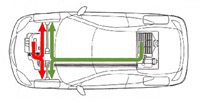 |
AccelerationDuring acceleration, power to the wheels is supplied by the IMA system's gasoline engine, assisted by the IMA electric motor. Electric power for the motor is stored in the Integrated Power Unit's (IPU) nickel metal hydride battery pack. |
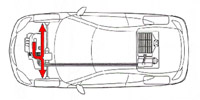 |
CruisingPower for steady-state cruising is supplied solely by the IMA system's gasoline engine. |
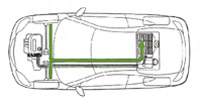 |
Deceleration and BrakingDuring deceleration and braking, the IMA system motor acts as a generator in order to recharge the IPU battery pack. |
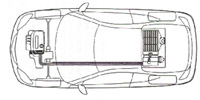 |
IdlingWhen the IMA system is idling, or when the idle-stop feature is engaged, the IPU battery pack is not supplying power or being recharged. |
| Source: Honda | |
The IMA system's idle-stop feature saves fuel and minimizes emissions when the Insight is stopped by temporarily shutting off the engine. The system is automatically engaged when the driver places the gear selector in neutral and takes his or her foot off the clutch. A green "Auto Stop" light indicates when this feature is operating. When the driver pushes the clutch pedal and engages the transmission, the IMA motor immediately restarts the engine. This feature will not operate if the battery charge is low, if the engine has not warmed up, or if the air-conditioning is operating on high. However, when the economy mode is selected, the idle-stop feature is engaged but will periodically keep the engine idling so that the air-conditioning can maintain a comfortable cabin temperature. If the transmission has not been shifted out of first gear, the idle-stop feature will keep the engine running so it will be ready to accelerate, and to conserve electrical energy.
Electricity for the motor is stored in a 44-volt nickel metal hydride (NiMH) battery pack. The battery pack and the Power Control Unit (PCU) are located under the cargo area floor. The PCU controls the flow of power between the motor and battery pack, regulates battery charge and controls the idle-stop feature.
V-TEC Engine
Primary motive power for the Insight is supplied by a 1.0 liter, 12 valve, 3-cylinder VTEC engine linked to a 5-speed manual transmission. By using lightweight materials such as aluminum, magnesium and plastic, the engine weight has been reduced to 124 pounds, making this one of the smallest and lightest 1-liter gasoline engines ever produced. Advanced technologies used in this engine include the compact VTEC-E cylinder head, integrated cylinder head and exhaust manifold, magnesium oil pan and the use of plastic resin for the intake manifold, valve cover and water pump pulley. The engine has Honda's sequential programmed fuel induction, and the ignition is a direct type with individual ignition coils for each cylinder and long-lasting iridium tipped spark plugs.
In addition the crankshaft axis has been offset 14 mm, relative to the cylinder-bore axis, so the crankshaft does not sit directly under the cylinder. This minimizes friction from the side thrust of the pistons against the cylinder walls, just after top-dead-center, as each piston begins its descent on the firing stroke. Honda claims this reduces internal friction by as much as three percent.
Lightweight Aluminum Body
Honda developed the first mass-produced aluminum bodied vehicle, the Acura NSX sports car. Building on this experience, the Insight was designed to use a new type of lightweight aluminum-copper alloy body. (The alloy contains copper for higher strength.) Stamped sheets, extrusions and die castings are all used to form a body that is both light and rigid. According to Honda, the aluminum body for the Insight is 40% lighter than a comparably sized steel body.
Electric Power Steering
Honda has installed an electric power steering system in the Insight. The electric power steering system (EPS) offers many advantages over conventional hydraulic systems. The pump, hydraulic fluid and hoses are all eliminated and because the engine is not constantly driving the pump, power losses are eliminated and fuel economy increases. The system is also simpler and more compact.
The EPS consists of a rack-and-pinion gear with a microprocessor controlled coaxial electric motor assisting the pinion. The microprocessor senses vehicle speed and steering torque and is programmed to vary the boost accordingly. Self-diagnosis and failure warning functions are built into the EPS system.
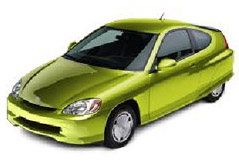 The steering rack, electric drive and tie rods are all mounted high on the bulkhead and steer the wheels via steering links on each front suspension strut. This design location allows a more compact engine compartment.
The steering rack, electric drive and tie rods are all mounted high on the bulkhead and steer the wheels via steering links on each front suspension strut. This design location allows a more compact engine compartment.
How Does It Work?
The engine (1 liter, 3 cylinder) can be smaller and more fuel-efficient because low-end torque and power assist are supplied by the electric motor. The electric motor and battery pack can be smaller and lighter than in a pure electric vehicle. The motor is not the only source of power and the battery pack does not need recharging from an outside source because the motor acts as a generator during deceleration and braking.
Copper Makes It All Possible
The advanced technology of the Honda Insight (and all other hybrid electric vehicles) is made possible by copper. The IMA system has a permanent magnet motor that is only 2.3 inches (60 mm) wide. This is made possible by the high efficiency of copper wire used for the motor windings. Heavy gage copper wire efficiently conducts electricity from the battery pack to the motor for increased fuel economy, and fuel economy gets an additional boost from both the electric power steering and the electronic controls for variable valve timing and lift. Copper is even added to the aluminum alloys in the lightweight body to improve strength and performance. Honda engineers have been reluctant to share detailed information on these new technologies but it is estimated that the Insight contains 50 - 60% more copper than a comparably equipped Civic Coupe. By relying on copper, one of the world's most durable and recyclable materials, Honda has developed technologies that will help to conserve our limited supply of fossil fuels and make our air cleaner.
![]() http://automobiles.honda.com/
http://automobiles.honda.com/
![]() http://evworld.com
http://evworld.com
Also in this Issue:
- Honda Insight Relies on Copper
- CuproBraze® Copper/Brass Radiators in Production
- All That Glitters is Mostly Copper - Part 2
- All That Glitters is Mostly Copper - Part 1
